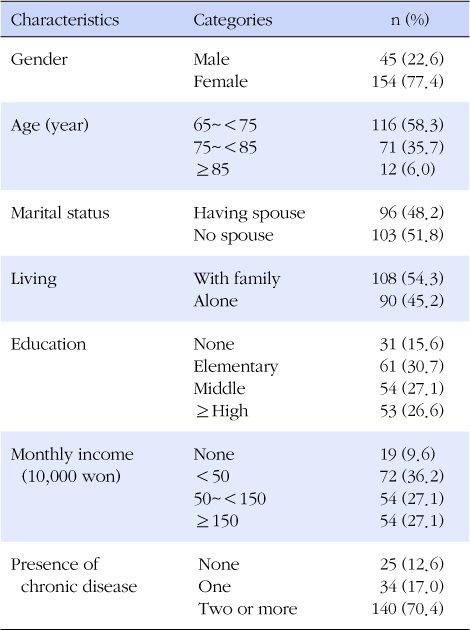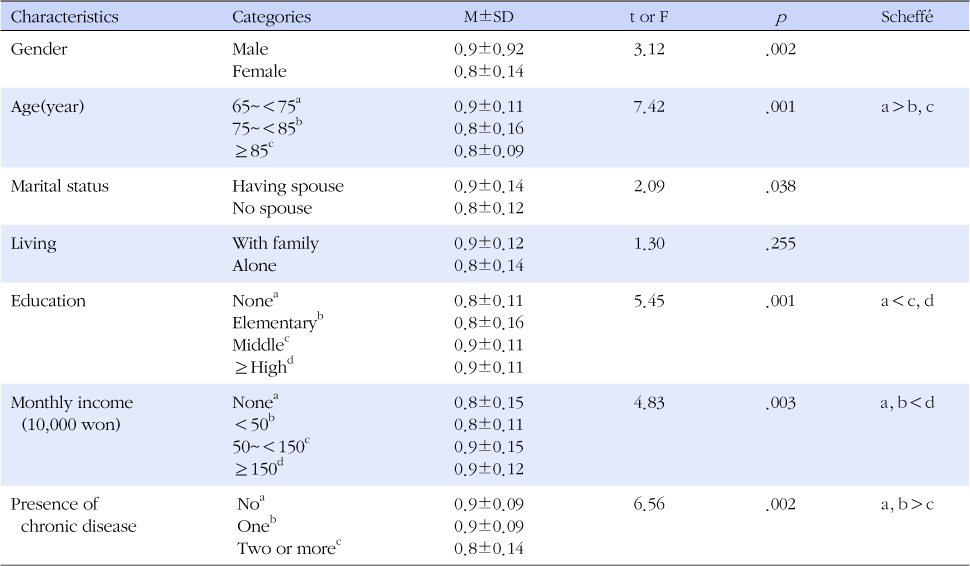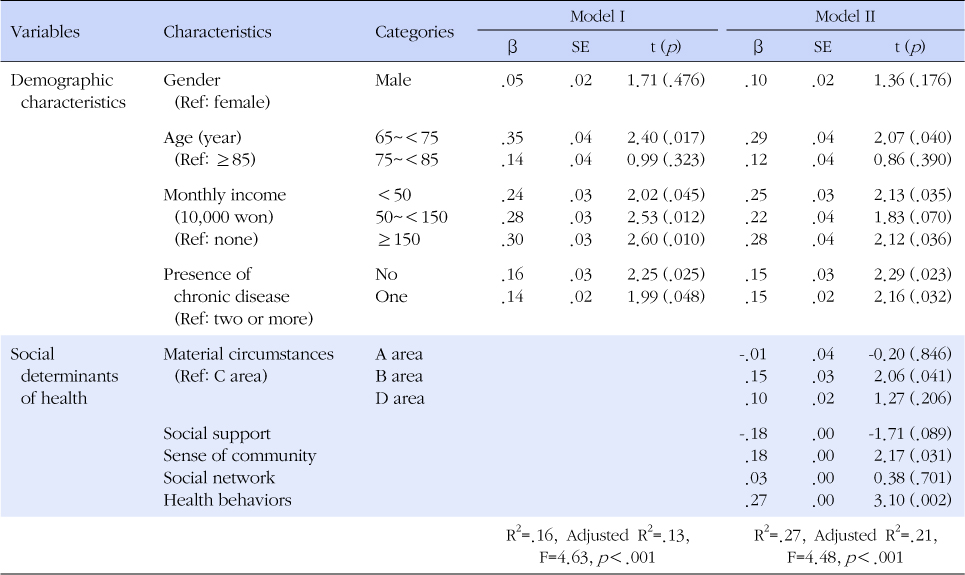Articles
- Page Path
- HOME > J Korean Acad Community Health Nurs > Volume 25(4); 2014 > Article
-
Original Article
- The Relationships between Social Determinants of Health and Health-related Quality of Life among the Community-dwelling Elderly
- Junghee Kim, Hyeonkyeong Lee, Chung Yul Lee, Eunhee Cho
-
Journal of Korean Academy of Community Health Nursing 2014;25(4):237-247.
DOI: https://doi.org/10.12799/jkachn.2014.25.4.237
Published online: December 31, 2014
1College of Nursing, Yonsei University, Seoul, Korea.
2College of Nursing, Nursing Policy Research Institute, Yonsei University, Seoul, Korea.
• Received: September 16, 2014 • Revised: October 29, 2014 • Accepted: November 24, 2014
© 2014 Korean Academy of Community Health Nursing
This is an Open Access article distributed under the terms of the Creative Commons Attribution Non-Commercial License (http://creativecommons.org/licenses/by-nc/3.0/) which permits unrestricted non-commercial use, distribution, and reproduction in any medium, provided the original work is properly cited.
- 680 Views
- 10 Download
- 4 Crossref
Abstract
-
Purpose
- The purpose of this study was to examine the social determinants of health (SDH) associated with health-related quality of life (HQOL) among the community-dwelling elderly, based on the conceptual framework of the Commission on Social Determinants of Health (CSDH).
-
Methods
- A survey was conducted with 199 elders aged 65 years or older sampled through convenient sampling. Data were collected through face to face interviews by trained interviewers using a structured questionnaire, which included scales of the residential area, social support, sense of community, social network, health behaviors, and HQOL. Data were analyzed by ANOVA and stepwise multivariate regression.
-
Results
- Major SDH affecting HQOL included the participants' residential area, sense of community, and health behavior. The HQOL of the elderly residing in the B area with a low rate of basic livelihood security recipients was higher than that of those residing in other areas.
-
Conclusion
- CSDH framework was useful to determine the factors associated with HQOL among the community-dwelling elderly. In addition to their health behavior, their sense of community was found to be a SDH of HQOL, indicating the need of health promotion programs tailored to the characteristics of residential areas and strategies to enhance involvement in community activities.
- 1. Statistics Korea. 2014 Elderly statistics [Internet] Seoul: Statistics Korea; 2014;cited 2014 September 29. Available from: http://kostat.go.kr/portal/korea/kor_nw/2/1/index.board?bmode=read&bSeq=&aSeq=330349&pageNo=1&rowNum=10&navCount=10&currPg=&sTarget=title&sTxt=
- 2. Ware J, Kosinski M, Dewey J, Gandek B. How to score and interpret single-item health status measures: A manual for users of the SF-8 health survey (with a supplement on the SF-6. Health survey). Lincoln, RI: Quality Metric Incorporated; 2001. p. 220.
- 3. Kim SY, Sohn SY. Factors related to health related quality of life in rural elderly women. J Korean Gerontol Nurs. 2012;14(2):91–98.
- 4. Kim JY, Lee SG, Lee SK. The relationship between health behaviors, health status, activities of daily living and health-related quality of life in the elderly. J Korean Gerontol Soc. 2010;30(2):471–484.
- 5. Kim JI. Levels of health-related quality of life (eq-5d) and its related factors among vulnerable elders receiving home visiting health care services in some rural areas. J Korean Acad Community Health Nurs. 2013;24(1):99–109. http://dx.doi.org/10.12799/jkachn.2013.24.1.99Article
- 6. Commission on Social Determinants of Health. Closing the gap in a generation: Health equity through action on the social determinants of health. Final Report of the Commission on Social Determinants of Health. Geneva, Switzerland: World Health Organization; 2008. Report No.: ISBN 978 92 4 156370 3.
- 7. Solar O, Irwin A. A conceptual framework for action on the social determinants of health. Social Determinants of Health Discussion Paper 2 (Policy and Practice). Geneva, Switzerland: World Health Organization; 2010. Report No.: ISBN 978 92 4 150085 2.
- 8. Gattino S, Piccoli N, Fassio O, Rollero C. Quality of life and sense of community. A study on health and place of residence. J Community Psychol. 2013;41(7):811–826. http://dx.doi.org/10.1002/jcop.21575Article
- 9. Cohen S, Hoberman HM. Positive events and social supports as buffers of life change stress. J Appl Soc Psychol. 1983;13(2):99–125.
- 10. Pretty G, Bishop B, Fisher A, Sonn C. Psychological sense of community and its relevance to well-being and everyday life in Australia. Australian Community Psychol. 2007;19(2):6–25.
- 11. Kim KJ, Kim SS. A study on the residents' sense of community in Korea. Community Dev Rev. 1998;23(2):211–232.
- 12. Oh YE, Lee JH. The effects of social network size and a sense of community on the loneliness of rural elderly-only households. J Community Welf. 2012;43:555–580. Article
- 13. EuroQol Group. EQ-5D-3L (Korean version for South Korea) [internet] Netherlands: EuroQol Group; 2003;cited 2014 March 28. Available from: http://www.euroqol.org/eq-5d-products/how-to-obtain-eq-5d.html
- 14. Lee YK, Nam HS, Chuang LH, Kim KY, Yang HK, Kwon IS, et al. South Korean time trade off values for eq 5d health states: Modeling with observed values for 101 health states. Value Health. 2009;12(8):1187–1193. http://dx.doi.org/10.1111/j.1524-4733.2009.00579.xArticle
- 15. Song MS. Construction of a functional status prediction model for the elderly [dissertation]. Seoul: Seoul National University; 1991. 141 p.
- 16. Lubben J, Gironda M, Lee A. Refinements to the lubben social network scale: The LSNS-R. Behav Meas Lett. 2002;7:2–11.
- 17. Hong M, Casado BL, Harrington D. Validation of Korean versions of the lubben social network scales in Korean Americans. Clin Gerontol. 2011;34(4):319–334. http://dx.doi.org/10.1080/07317115.2011.572534Article
- 18. Walker SN, Sechrist KR, Pender NJ. The health-promoting lifestyle profile: Development and psychometric characteristics. Nurs Res. 1987;36(2):76–81. http://dx.doi.org/10.1097/00006199-198703000-00002
- 19. Hong YA. (The) effect of health screening on health promotion behaviors in the elderly [master's thesis]. Seoul: Yonsei University; 2003. 61 p.
- 20. Ministry of Health and Welfare. 2012 National health statistics: The fifth korean national health and nutrition examination survey [internet] Seoul: Ministry of Health and Welfare; 2013;cited 2013 December 24. Available from: https://knhanes.cdc.go.kr/knhanes/index.do
- 21. Boltz M. Evidence-based geriatric nursing protocols for best practice. 4th ed. NY: Springer Publishing Company; 2012. p. 2037.
- 22. Seodaemun-gu Health Center. 2014 Implementation plan(the fifth regional health planning) [internet] Seoul: Seodaemungu Health Center; 2014;cited 2014 March 25. Available from: http://health.sdm.go.kr/guide/ntc/ntcLst.do?BOARDCODE=BD07120000&gMenuCode=BD07120000
- 23. Seodaemun-gu. The 28th statistical yearbook of Seodaemun 2013 [Internet] Seoul: Seodaemun-gu; 2014;cited 2014 January 16. Available from: http://hj2-dong.sdm.seoul.kr/admininfo/regulations/statisticsdata.do
- 24. Murata C, Yamada T, Chen C-C, Ojima T, Hirai H, Kondo K. Barriers to health care among the elderly in Japan. Int J Environ Res Public Health. 2010;7(4):1330–1341. http://dx.doi.org/10.3390/ijerph7041330Article
- 25. Kitchen P, Williams A, Chowhan J. Sense of community belonging and health in Canada: A regional analysis. Soc Indic Res. 2012;107(1):103–126. http://dx.doi.org/10.1007/s11205-011-9830-9ArticlePDF
- 26. Hystad P, Carpiano RM. Sense of community-belonging and health-behaviour change in Canada. J Epidemiol Community Health. 2012;66(3):277–283. http://dx.doi.org/10.1136/jech.2009.103556Article
- 27. Lee WK, Jung SH. Policy suggestions on neighborhood-making project based on aged society - focused on questionnaire survey result of neighborhood-making activists. Urban Design Institute of Korea. 2014;15(1):137–150.
- 28. Gu MO, Eun Y, Kim ES, Ahn HR, Kwon IS, Oh HS, et al. Effects of an elder health promotion program using the strategy of elder health leader training in senior citizen halls. J Korean Acad Nurs. 2012;42(1):125–135. http://dx.doi.org/10.4040/jkan.2012.42.1.125Article
- 29. Kim SH. Effects of a volunteer-run peer support program on health and satisfaction with social support of older adults living alone. J Korean Acad Nurs. 2012;42(4):525–536. http://dx.doi.org/10.4040/jkan.2012.42.4.525Article
- 30. Jeon EY, Choi YH. Factors affecting the health-related quality of life according to age in vulnerable aged men. J Korean Acad Nurs. 2010;40(3):400–410. http://dx.doi.org/10.4040/jkan.2010.40.3.400Article
Figure & Data
References
Citations
Citations to this article as recorded by 

- Influence of cognitive function and social support on health-related quality of life of elderly men in partial medically underserved rural areas: A cross-sectional study
Min Hye Hwang, Hye Kyung Lee
Journal of Korean Gerontological Nursing.2023; 25(2): 163. CrossRef - A comparison of health-related quality of life and personal, social, and environmental factors of older adults according to a residential area: a propensity score matching analysis
Jungmi Yun, Yeongsuk Lee, Hyun-Ju Lee
Quality of Life Research.2022; 31(9): 2631. CrossRef - The Effects of Health Behavior and Health Status on Heath-related Quality of Life in Older People: Gender Analysis by using the 2012 Korea Health Panel Data
Min-Jeong Park, So Eun Choi
Journal of Korean Academy of Community Health Nursing.2017; 28(2): 118. CrossRef - Comparison of Health Status and Mini Nutritional Assessment according to Self-esteem of Elderly in Care Hospital
Eun-mi Kim, Jin Kwon
Journal of the East Asian Society of Dietary Life.2015; 25(4): 631. CrossRef

 KACHN
KACHN





 PubReader
PubReader Cite
Cite

